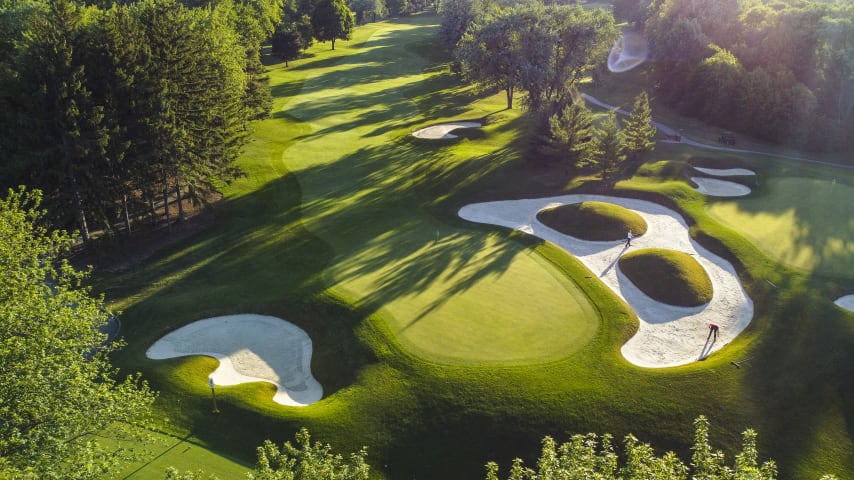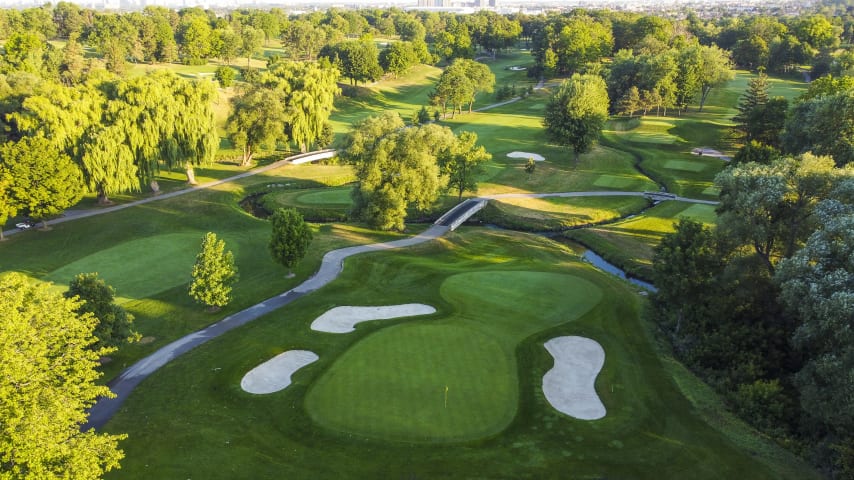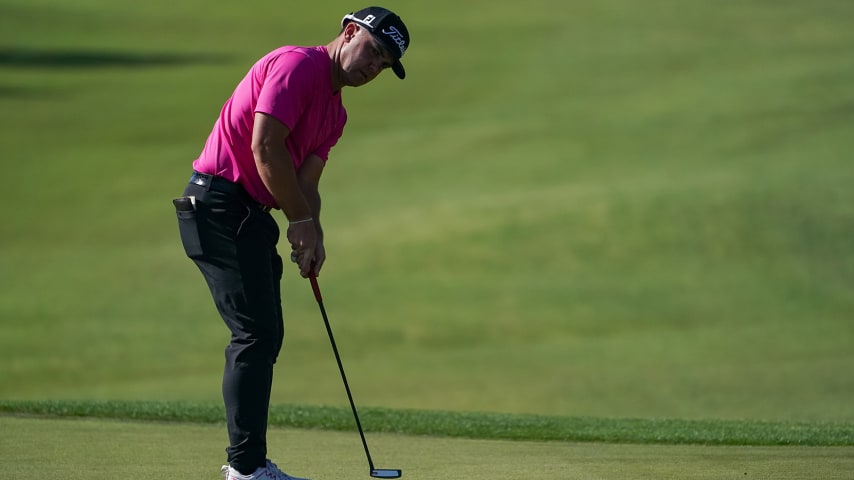Five things to know: Oakdale Golf Course
6 Min Read

Written by Adam Scott
Outside of the majors, the RBC Canadian Open is one of just two events on the PGA TOUR schedule that is not contested at the same golf course as the prior season. That makes it a special part of Canada’s national open – the third-oldest continuously run event on TOUR after the U.S. Open and Open Championship.
This year the event heads to Oakdale Golf and Country Club in Toronto, about 15 miles from the city’s downtown core. Oakdale, established in 1926, will be the 37th host course of the RBC Canadian Open in the tournament’s 117-year history.
After two years of cancellations due to the COVID-19 pandemic, the RBC Canadian Open returned with gusto last year at St. George’s Golf and Country Club where Rory McIlroy successfully defended his title at one of Canada’s classic clubs.
Renowned Canadian architect Stanley Thompson – who also originally designed St. George’s – laid out the original 18 holes at Oakdale, while Robbie Robinson (who apprenticed under Thompson) added nine holes in the late 1950s.

Flyover: Oakdale Golf & Country Club | 2023 RBC Canadian Open
This will be the first time the Canadian Open has gone to a golf course designed by Robinson, who is a Canadian Golf Hall of Famer.
With 27 holes, the property is big enough to make sure the best in the world can prepare appropriately (two holes have been converted into the tournament driving range while the member’s driving range is set to be a music venue for Friday and Saturday-night concerts) and fans from North America’s fourth-most populated city can see if McIlroy will make it a three-peat, or, perhaps, one of the 19-plus Canadians in the field – led by Corey Conners, who is tops on the FedExCup – will make a little history.
With this being a first-time venue, here are five things to know about Oakdale Golf and Country Club.
COMPOSITE ROUTING
Each of the nine holes at Oakdale are named after Canadian icons in the sport. There is the Thompson (named after architect Stanley Thompson), the Knudson (named after eight-time PGA TOUR winner George Knudson), and the Homenuik (named after long-time Oakdale head pro and Canadian Golf Hall of Famer Wilf Homenuik).
For the RBC Canadian Open, the front nine will be made up of four holes from the Thompson and five holes from the Homenuik. The full Knudson nine will make up the back nine.
The front nine will play nearly 400 yards longer, at approximately 3,800 yards, while the back nine will be approximately 3,400 yards. It will play as a par-72, with two holes being converted to par-4s for the TOUR’s best (the third hole and sixth hole).
“At a high level, players are going to have to hold on with two hands on the front nine. That’s where the scores are going to be a little higher,” said Alex Arychuk, the head golf professional at Oakdale. “But then there will be a lot of birdies made down the stretch on Knudson played in its entirety.”

SUCCESS TO COME INTO THE GREENS
As Arychuk says, there is a premium on accuracy, with the “major defense” of Oakdale being the small greens.
“We’re not the longest golf course, but speaking specifically off the tee, there are a couple of fairways heavily sloped, so golfers will need to land it into the right portion,” he explained. “(The greens) are not necessarily the most well-bunkered but there is great undulation and tricky slopes.”
Black Creek runs through the course so players will have to think twice about whether their putts will break towards the creek or not, Arychuk said.
Conners and Mackenzie Hughes played a practice round with Arychuk two weeks before the RBC Canadian Open, and the head pro said the two TOUR winners spent most of their time understanding the greens and how the ball would react in certain areas as most of the approaches will come from a sidehill, uphill, or downhill lie.
GENERATIONAL ARCHITECTURE
This will be the second year in a row the RBC Canadian Open will be contested on a golf course originally designed by Stanley Thompson before Ian Andrew, a restoration specialist and Canadian architect, put his touches on the layout.
Andrew began working with Oakdale in 2017. The biggest effort of the project was modernizing and cleaning up bunkers on all 27 holes. The bunkers had begun to stray from Thompson’s original design while the Knudson nine’s aesthetic was matched by Andrew to Thompson’s original 18-hole layout by removing hundreds of artificial mounds, according to Golf Course Magazine.
Andrew also worked with St. George’s as it prepared for the 2022 RBC Canadian Open, so working with the TOUR was familiar to him.
“Oakdale’s composite routing for the Canadian Open showcases Stanley Thompson, Robbie Robinson, and Ian Andrew’s work – three unique generations of Canadian golf architecture coming together in true Canadian-celebration fashion,” said Andrew Harvie, a Canadian golf-course architecture expert and founder of the blog Beyond the Contour. “You get some of Thompson’s flashy bunkers and usual artistic flair while seeing Robbie’s unique green shapes plus showcasing Andrew’s restoration specialties.
“It is a course that showcases the progression of Canadian architecture over the last 100-plus years.”

TOUR TWEAKS
A few extra tee blocks and an extra bunker were added to the back nine to prepare for the TOUR, while work on the fairways, drainage, and irrigation systems were also projects completed before this year’s RBC Canadian Open. How the golf course would come through a Canadian winter would always be a question mark (funny enough, the first time TOUR officials came for a visit it was during a snowstorm), but Mother Nature was kind to the Toronto area after Halloween.
While the club’s director of property management, Patrick Greenman, volunteered with the turf and maintenance team during the week of THE CJ CUP to understand the daily effort needed for a TOUR event, there was a test-and-learn event in 2022 – the Monday qualifier for the 2022 RBC Canadian Open was contested at Oakdale.
The big change from last year’s qualifier is that the 18th hole – which played as a full shot over par then – has been converted from a par-4 to a par-5.
At the time, it was the hardest hole on the course, with the par-4 6th ranked as the second-most difficult. The front nine had six of the hardest seven holes during the Monday qualifier in 2022.
“It’ll be tough on the front nine with a couple of converted par fives now par fours into smaller greens but in the back that’s where the (scoring) opportunities will present themselves,” said Arychuk, the head pro.
ON A ROTATION
While Oakdale will become a first-time venue for the RBC Canadian Open this year, the event is set for Hamilton again next year. There is no confirmed venue for 2025, but Oakdale is hopeful the tournament will make an exciting return in 2026 – just in time for its centennial celebration.
“(The RBC Canadian Open is about) the PGA TOUR, it’s Golf Canada, but it’s also a reflection of Oakdale so behind the scenes we are working very hard. We’ve got a great team here who is happy to be a part of it and wants the Open to return in 2026,” said Arychuk. “That’s our focus as we look forward to our centennial year, it would be a nice feather in our cap as well.”
Glen Abbey Golf Course has hosted the most RBC Canadian Open events in history, with 30 between 1977 and 2018.
Hamilton is once again set to host in 2024, where McIlroy won by seven shots in 2019.





